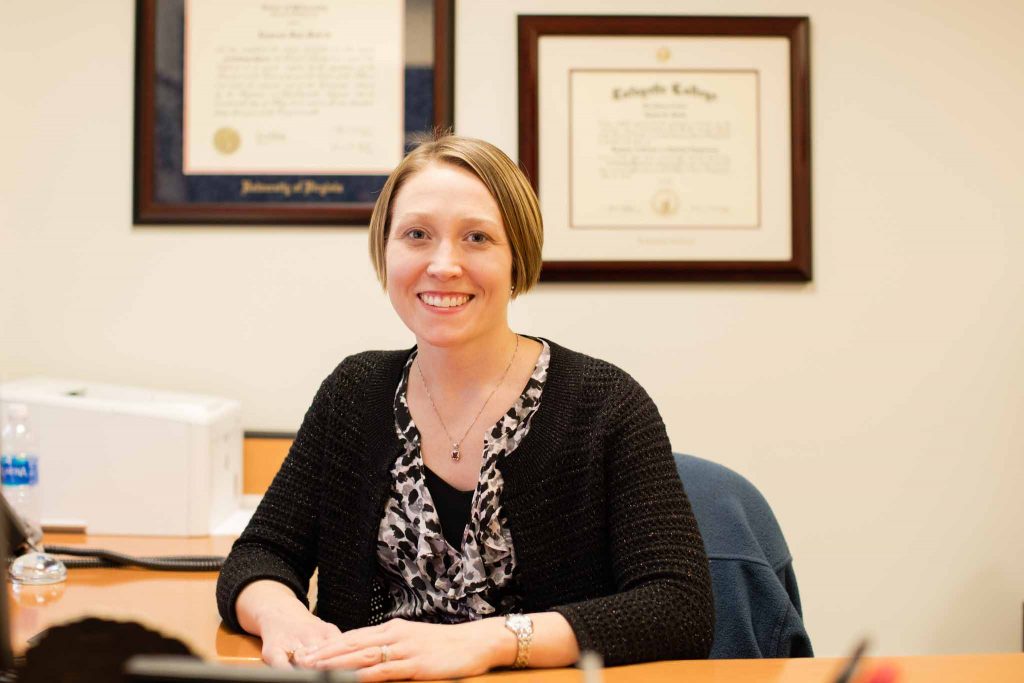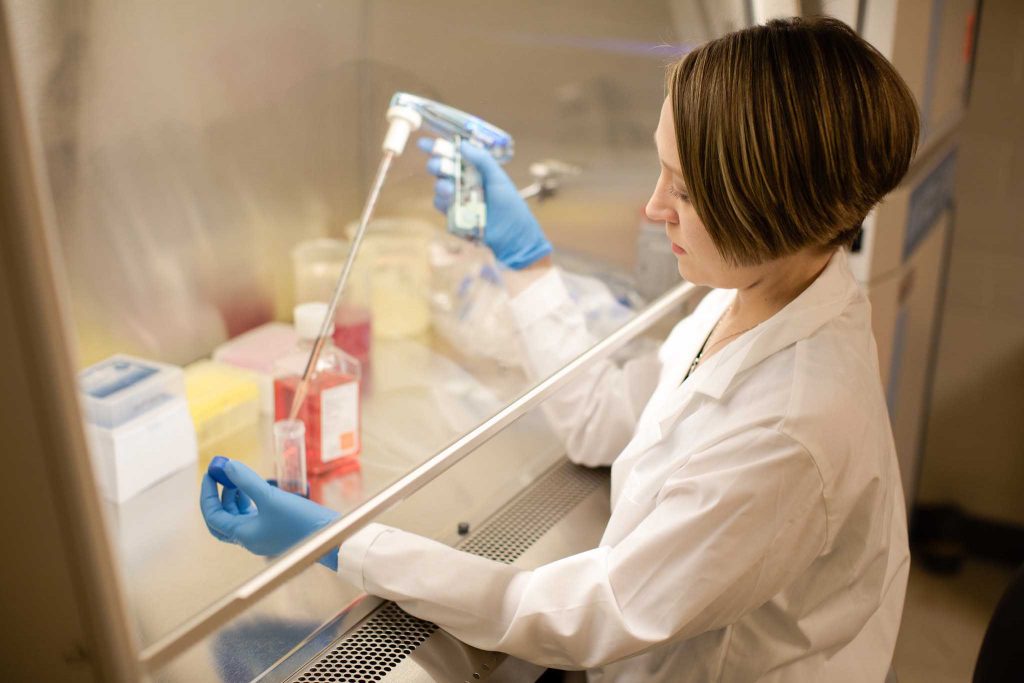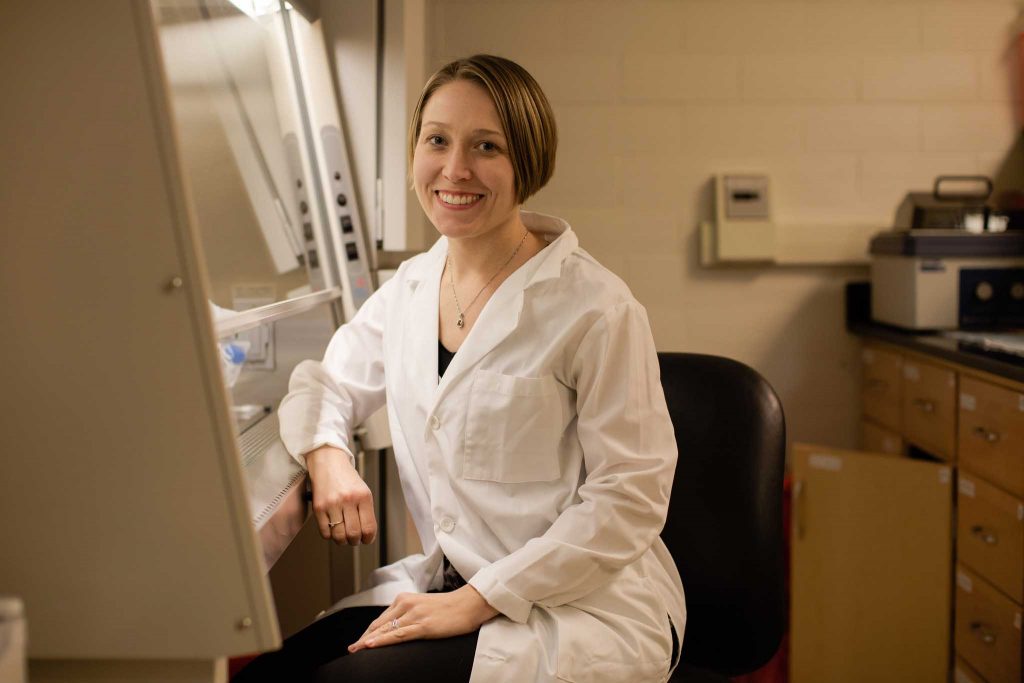Prof. Lauren Anderson discovered a passion for teaching and mentoring students
 By Bryan Hay
By Bryan Hay
Lauren Anderson ’04 often returns to a very personal moment as a teenager when it became clear she was destined to become a bioengineer.
“My initial passion was all about my grandma’s knees,” she says. “She had a knee replacement, and I remember asking, ‘How are they going to implant an artificial limb, and how is it going to work?’”
“I had so many questions. Who made this? What’s it made out of? How’s the body not going to reject it? Will she need to have it replaced again?”
At the time, undergraduate programs for bioengineering were still new.
“I was visiting colleges and looking at the traditional paths of mechanical engineering and chemical engineering,” says Anderson, who heads the chemical and biomolecular engineering department. “I chose chemical engineering because I realized that I liked chemistry and the molecular approach. I chose a foundation in chemical engineering and decided to delay my interests in bioengineering for graduate work.”
Anderson is working in tissue engineering, a field of research that brings great promise to the field of medicine. She is exploring the interface between cells and thermoresponsive polymers, which can be used to create sheets of cells for transplantation without risk for rejection.
In a recent interview, she talked in depth, with limitless enthusiasm, about her research, inspirations, and teaching styles, and why Lafayette has always felt like home.

Why did you choose Lafayette as a student and to establish your academic career?
As a student, I was looking at small liberal arts colleges with engineering. In high school, in addition to taking AP math and science courses, I was also in advanced art courses. I really enjoyed drawing and painting. I wanted an environment where students were interested in things other than engineering, a place where engineers could be part of the band, play sports, and be part of Greek life.
I returned to Lafayette for similar reasons. While in graduate school, I discovered a passion for teaching and mentoring students. I love that Lafayette students have many interests and that engineering students are active members of the campus community. They bring these experiences to the classroom, and it helps them develop a more creative approach to problem- solving.
What’s your main area of research and your aspirations for how it might change or benefit society?
My research is in the area of tissue engineering, specifically examining the interface between cells and materials. I am exploring thermoresponsive polymers for their ability to serve as an alternative cell-culture substrate for growing cell sheets for eventual transplantation. Current protocols for removing cells from standard culture plates require the use of biochemical enzymes, which disrupt both cell-cell and cell-matrix interactions, both of which are important mediators to maintaining cell phenotype, which is basically a cell’s distinct personality.
My most recent project is investigating novel fabrication techniques to produce aligned nanofibers of a thermoresponsive polymer for use as a vascular graft. In cardiovascular bypass surgery, usually a vein is taken from the leg to replace the diseased portion of an artery. For older patients or those with complications from diabetes or other ailments, there is not always a good supply of vascular tissue. This project is aimed at designing biomimetic materials that could support cell-sheet growth and aid in the development of off-the-shelf vascular grafts.
What exciting things can you anticipate for the future in your area of research expertise?
Since I study the interaction between biomaterials and cells for the purpose of engineering more biologically relevant tissues, I am always looking to work with others whose expertise lies in creating new polymers or modifying the surface chemistry of existing materials. For example, there exist other types of stimulus responsive polymers, such as pH or light-activated polymers. Surface properties can be tailored in countless ways to drive the cellular response.
How would you describe your teaching style and how you go about preparing chemical engineers to apply their skills to real-world problems?
My teaching style varies for different types of courses and for different grade levels of students. I try to keep in mind that the needs and expectations of a first-year student are different than a senior’s. But nonetheless, all my efforts are focused on preparing students to be independent thinkers and find a genuine curiosity for some aspect of the course. I try to teach students to learn how to ask the right questions. One of the most valuable academic exercises I’ve had was the oral comprehensive exam in graduate school. No matter how much I prepared, there was going to be a point at which I didn’t know the answer to a question. Learning how to handle these situations, think on my feet, and relate something I don’t know to something I do know are valuable skills. I want students to mature in their thinking, to not be afraid of failure and learn how to move past stumbling blocks.

What’s your favorite course that you teach and why?
Can I have two favorites? I love CHE 311 Transport Phenomena because it is a rigorous applied problem-solving course. I enjoy working with the students and watching their development throughout the course. Because problems in the second half of the course can be solved by analogy to those learned in the first part of the course, it is gratifying to see students develop their problem-solving ability over time. It’s a difficult course, but most students appreciate the challenge and end up feeling like they’ve learned a lot.
My other favorite is my elective, Biomolecular Engineering. This is a special topics course on how chemical engineers can contribute to the field of bioengineering. We focus on the molecular and cellular aspects of bioengineering. There are hands-on lab exercises, such as learning how to culture cells, measure cell growth over time, and a final project where students design their own 10-week summer research project. Several students have turned these final projects into honors theses, and for several others, this course was the reason they applied to jobs or grad school in the bio sector. That is incredibly rewarding.
What does it mean to you to mentor young women through the Clare Boothe Luce (CBL) Research Scholars Program?
Mentoring young women in research opportunities is one of my favorite parts of the job. These one-on-one interactions, and the downtime that exists between experiments, especially in the summer, allow for some truly amazing conversations. I found that the female students I’ve worked with are very curious about things like work-life balance, having children and a career, and how to navigate traditionally male-dominated fields. The CBL Scholars Program has been a transformational experience for many of these young women. Not only do they gain research experience, but they become part of a supportive community of other female engineers.
How does Lafayette’s liberal arts approach help support independent and creative thinking in the sciences and engineering?
Students have different mindsets. They are not focused on the purely technical aspects of engineering, but how they can apply what they are learning to improve the world they live in. They care about making a difference. They bring diverse backgrounds into the classroom. We have very interactive classrooms here.
Who were some of the people who have influenced your career?
I have enormous gratitude for my parents and a lot of appreciation for the value that they placed on higher education. Although I am a first-generation college student, my parents really instilled in me the importance of going to college and identifying a career path that would be personally fulfilling. I’m not sure where I’d be now if education wasn’t a priority growing up.
I’ve been fortunate in my life and career to have support from so many caring people. It’s because of them that I look for ways to give back and inspire future generations.
 By Bryan Hay
By Bryan Hay
